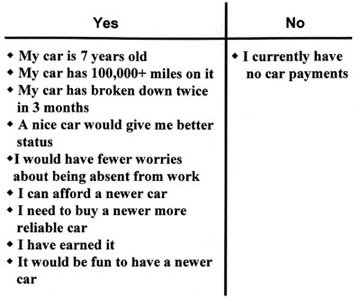|
The Ben Franklin Balance SheetThe Ben Franklin Balance Sheet Close is a method some top salespeople use to help clients decide. It is useful as an individual decision-making tool as well. A famous sales trainer, Tom Hopkins, calls it: “One of the most magnificent closes that have ever come into the selling profession.”
Ben Franklin developed the balance sheet close because of his remarkable common sense. He used it to make some of his most important decisions. It is used to make yes or no decisions. To use this method, take a clean sheet of paper and draw a line down the center. On the left side of the line, write the word “Yes.” Underneath it, write all the arguments for the decision. On the right side of the paper, write the word “No.” Underneath it, write all the arguments against the decision. When completed, count the number of arguments for the decision on the left side of the paper. Then, count the number of arguments against the decision on the right side of the paper. Frequently, the decision becomes obvious.
Here is an example using the Ben Franklin Close to determine whether to purchase a newer car. This is similar to the stream of logic method shown earlier:
To use the Ben Franklin Balance Sheet take a clean sheet of paper and draw a line down the center. On the left side of the line near the top write the word “Yes.” Underneath it write all the arguments for the decision. On the right side of the paper write the word “No.” Underneath it write all the arguments against the decision. When completed, count the number of arguments for the decision on the left side of the paper. Then count the number of arguments against the decision on the right side of the paper. Frequently, the decision becomes obvious, especially when one of the sides clearly has more arguments listed. 1 To learn more see the book: Mastering Critical Thinking to learn more. The Ben Franklin close is for a man named Jack who is trying to decide whether or not to purchase a new car. The “Yes” column is for reasons to buy a car. The “No” column is for reasons against buying a car. The Ben Franklin Balance Close Sheet The individual’s decision is relatively straightforward. There are many good reasons to buy a newer car and only one reason not to. The decision might be more difficult if this person didn’t have a good-paying job or if his existing car was newer and more reliable.
Notes: 1. The Ben Franklin Balance sheet can easily be modified using “Major Pros” and “Major Cons” instead of “Yes” and “No” when exploring a potential purchase. For example, use the: a. Major Pros column is for reasons to buy a car. b. Major Cons column is for reasons against buying a car. 2. Use whatever method works best for you, including the stream of logic method shown earlier.
To learn more see the book:
Return from Ben Franklin Balance Sheet to Problem Solving Techniques |


